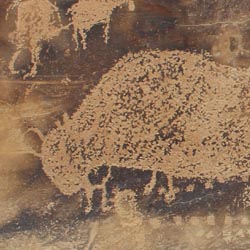


Hype:
Nine Mile Canyon is home to some of the best rock art in Utah. The petroglyph panels include the Great Hunt Scene, the 10 Little Indians, the Big Buffalo, and many others.
Time:
Fees: None
Recommended Ages:
 | 0-3 |
 | 4-11 |
 | 12-19 |
 | 20-49 |
 | 50-69 |
 | 70+ |
Recommended Months to Visit:
| Jan |
| Feb |
| Mar |
| Apr |
| May |
| Jun |
| Jul |
| Aug |
| Sep |
| Oct |
| Nov |
| Dec |
Links: http://climb-utah.com/Misc/ninemile.htmhttp://www.myxj.net/blog/nine-mile-canyon-set-1/http://jpgmag.com/stories/16170https://thetrekplanner.com/9-mile-canyon-driving-guide-utah/
Navigate to 39.780211, -110.135072.
The Daddy Canyon Complex is home to several petroglyph panels. The first grouping of rock art is a large cave or rock shelter called Rassmussen Cave.
Under the rock shelter, there are some cool grooves in a large boulder. I'm guessing these were for grinding corn.
On the walls of the cave are lots of petroglyphs depicting big horn sheep, other animals, and people.
To the right of Rasmussen Cave is another, smaller rock shelter with several petroglyphs.
The Daddy Canyon Recreation Site has a bathroom, some picnic tables, and some shade canopies (ramadas). It also marks the trailhead for the Daddly Canyon Trail.
The first petroglyph panel is on the left (west) of the trail. Then you cross the wash to the east wall of the canyon. On the east wall are a bunch more petroglyph panels. Turn right and follow the east wall to the southeast
Around the corner from the Great Hunt Panel are several other interesting petroglyphs including this one of "The Alien".
The Big Buffalo Panel is a bit tricky to find. There is a sign on the road and a pullout, but there isn't a trail. Basically just wind your way through the bushes until you get to the east wall and look for a huge buffalo petroglyph.
The "Big Buffalo" is huge for petroglyphs: about 3 feet long and 2 feet tall.
Besides the Big Buffalo, there are also lots of other petroglyphs in the panel. They include sheep, people, snakes, grids of dots, lines of dots, concentric circles, and squiggles.
At the mouth of Cottonwood Canyon, there is a pullout and a sign that directs people to the Fremont Village.
I walked past it twice before I realized what I was looking at. The Fremont Village is not actually a village. It's the remains of one dwelling. There are a bunch of rocks in a square.
While I was looking for the Ten Little Indians panel, I found this little rock shelter with some faded petroglyphs in it.
On the underside of an otherwise insignificant rock are several Fremont-style pictographs. The name is a little bid misleading because there are actually just 8 little Indians.
To the left of the Ten Little Indians panel and easily visible from the road are a bunch of petroglyphs.
In addition to all the rock art, Nine Mile Canyon is home to many historic buildings.
The CottonWood Glen Picnic Area is a good place to have a picnic. There is a historic cabin and the remnants of a chimney and an old well.
This unnamed panel has lots of petroglyphs. There are grids of dots, squiggles, animals, and people.
Closest City or Region: Wellington, Utah
Coordinates: 39.780211, -110.135072
By Jeremy Dye
Jeremy Dye, Tara Dye, Savannah Dye, Madilyn Dye, Cooper Dye,
We drove through Nine Mile Canyon on our way home from the family reunion in Vernal. The kids got out to see some of the more impressive panels like the Rasmussen's Cave, the Great Hunt, and Ten Little Indians. But the kids were listening to an audio book, so Tara and I did most of the other little hikes without them. It was really nice to be in the passenger seat while Tara was driving so I could scan the cliffs as we drove by. We drove slowly and anytime I saw something that looked picture-worthy, I would shout it out and Tara would throw it in reverse. We found quite a few previously-unknown-to-us panels this way.
 Utah Field House of Natural History State Park Museum
Utah Field House of Natural History State Park Museum
By Jeremy Dye
I visited Nine Mile Canyon on my way home from Duchesne. I started in Myton and ended in Wellington.
After about 33 miles (all but the last 5 or so were paved), I got to the junction of Nine Mile Canyon Road and Nine Mile Canyon Road (I know, it's confusing). I went East up to the Daddy Canyon Complex and up to the Great Hunt Panel before turning around and heading down to Wellington.
The first stop I made was at Rasmussen Cave. Then I stopped at the Daddy Canyon Recreation Site and took the Daddy Canyon Trail. I found that this area was a little confusing. I guess I should have looked at the map a little closer before I set off. After I viewed the east wall petroglyphs, instead of turning right and following the east wall to the southeast, I followed the trail to the left and went up canyon. Now don't get me wrong; up canyon is very scenic and a good little hike, but there isn't any rock art up canyon that I could find. I went up canyon about two-thirds of a mile until I came to a waterfall. Since I couldn't scale it without getting wet, I turned around and went back to the parking lot. I missed the rock art on the east canyon walls. When I go back, I won't make the same mistake again.